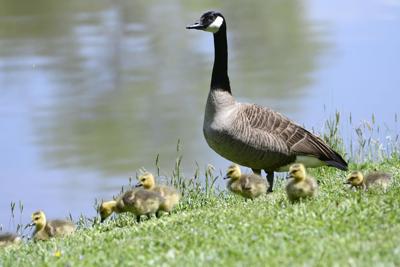PRINCETON — They’re big and beautiful birds when they’re flying in formation overhead or swimming in a river or lake, but they’re also nuisances that tear up yards and leave their messy droppings behind.
Canada geese are frequently seen feeding around local lakes and rivers, especially in areas that offer lawns where they can graze and watch out for predators at the same time. Places like the mowed lawns around Glenwood Lake are good examples to the habitats that the geese like.
Geese leave their droppings around some of the park’s lakeside trails and areas near parking lots and playgrounds. Park officials have had to take some actions to shoo them off.
“Oh yea, we’ve done some things to discourage them because they tend to leave a mess everywhere,” County Commissioner Bill Archer said. “They are a nuisance. They’re beautiful creatures, but they do make a mess. “I know (Park Superintendent) Kevin Dials has tried to address the situation.”
Besides Glenwood Lake, places like the spacious lawns around the Gardner Center, formerly the U.S. Forestry Service Lab, have seen flocks of Canada geese.
“Out at the Gardner Center, they take up residence in that large front yard,” Archer said. “There is a pond off of Cornbread Ridge Road where they’re hanging out. Brushfork Creek runs on the other side of Mercer Springs Road.”
Dials has had previous encounters with the birds.
“Well, Canada geese obviously like lakes and they also thrive in mowed areas that you find in most parks,” he said. “We’ve not had as much of a problem this year as we have in the past.”
Visitors were feeding domestic Peking Ducks and domestic geese that had been “dumped” in the lake, Dials recalled.
“People were feeding those, and Canada geese were taking advantage of all that food being left,” he stated.
Making sure they don’t have an easy food source has helped discourage geese from stopping to feed.
“We’re not having that situation where so many are hanging around at the front of the park,” Dials said. “They’re not as dense as they were. They’re forging where they’re supposed to and undoubtably spreading out for more readily available food sources. We’ve done sort of a public information campaign, talking to people when we see them putting out feed; and we’ve cut back on that, which seems to have been the biggest remedy to the situation.”
Dials dealt with Canada geese when he worked at a state park.
“My earliest job was at Beech Fork State Park, and we had a scare-away gun that shot what was basically a firecracker,”he recalled. “And if you scare them away from the campground, they would fly over to the swimming pool; and if you scare them away from the swimming pool, they fly back to the campground. It has a very short-term effectiveness.”
Dials said special equipment has not been used at Glenwood. He’s driven towards flocks and honked his horn. Sometimes, it scares the geese off, but they then come back.
The biggest deterrent has been to avoid mass feedings.
“When we do that, the large numbers (of geese) comes and they leave larger messes with their droppings and feathers and such,” Dials stated. “When we don’t deliberately make them flock to one area, it sort of takes care of itself.”
Canada geese don’t tend to nest around Glenwood Lake. Dials said that he has seen “one little group of goslings.” Predators are one reason why geese tend to nest in smaller ponds and areas with streams.
“The lakes with larger fish and turtles are actually really hard on those goslings,” he said, adding that snapping turtles have been seen in Glenwood Lake. In one instance, a dead snapping turtle some visitors found was reported as a dead alligator.
Todd Dowdy, district wildlife biologist with the West Virginia Department of Natural Resources (WVDNR) said that aside from some Canada Geese that have had “nest fails,” most of them have already hatched out goslings.
“I’ve already see a lot of young geese, hatchlings,” he said.
The WVDNR offers property owners tips on deterring Canada geese that either try to feed on their land or nest there. Harassing them constantly so they don’t feel comfortable which can be effective.
Allowing grass or other vegetation to grow along the banks of a lake or stream can deter geese because it blocks their view of potential predators, making them uncomfortable, Dowdy said. They do not like walking through tall grass or thick brush where they can’t see well.
“They love golf courses, of course,” he added. “They love that young grass and the visibility.”
Temporary fencing and other obstructions that keep geese from going to and from water can help, Dowdy said. and like Dials, he advised people to avoid feeding them.
People with nuisance geese and other wildlife problems can call the WVDOH District 4 office at 304-256-6947 for advice.
— Contact Greg Jordan at gjordan@bdtonline.com




















Commented
Sorry, there are no recent results for popular commented articles.